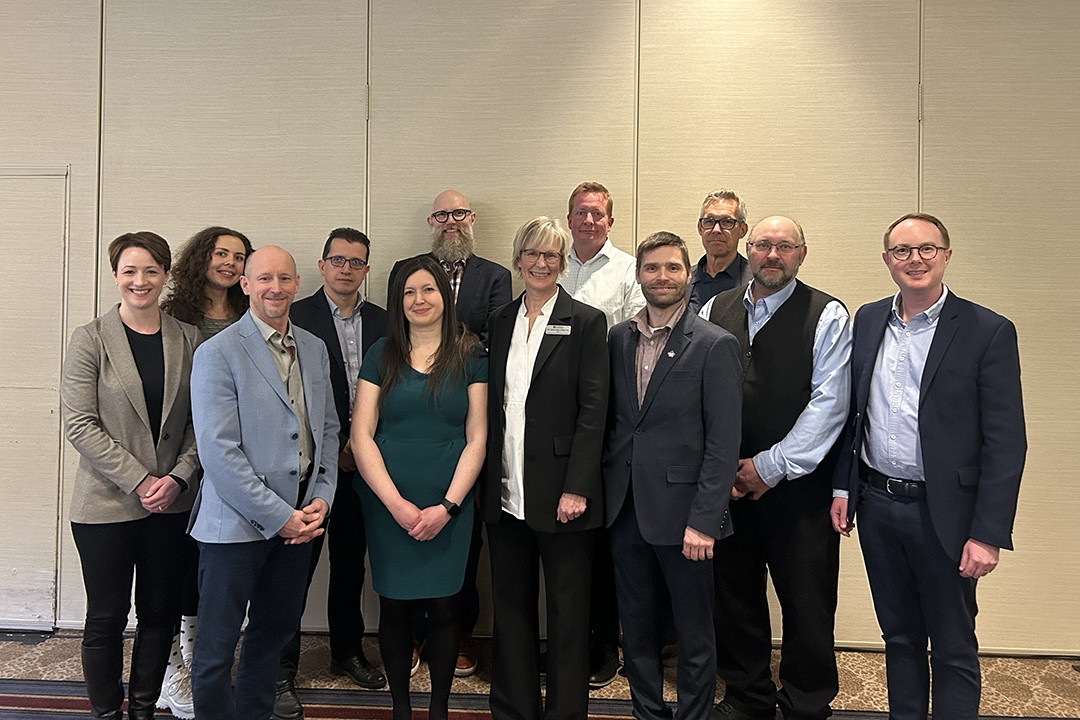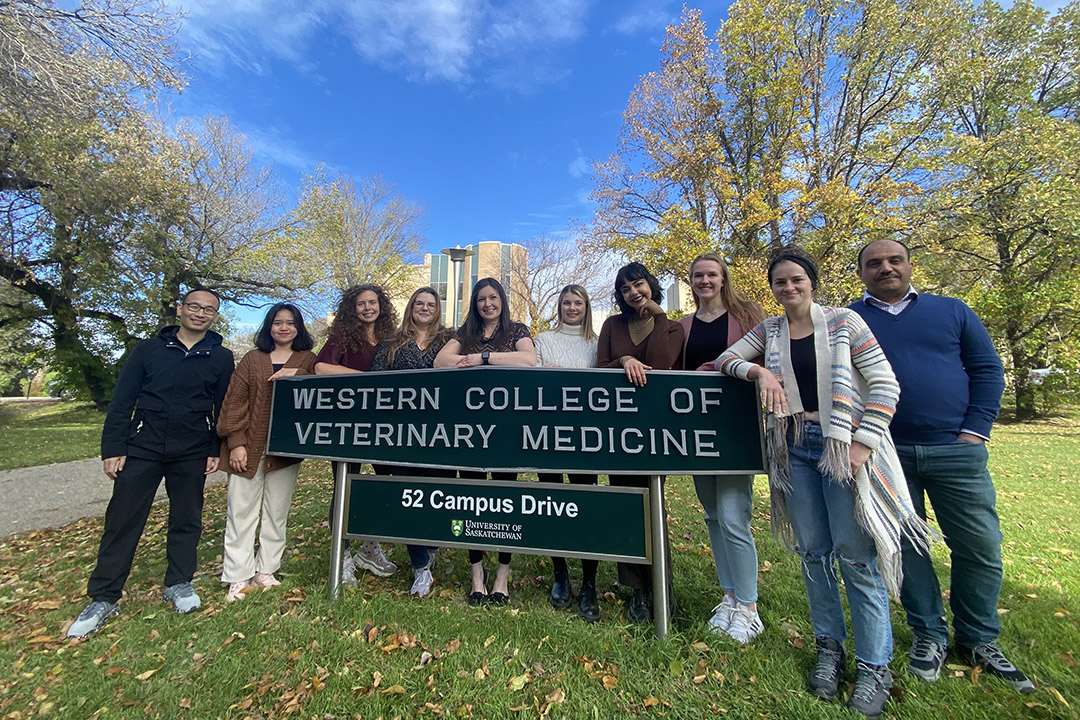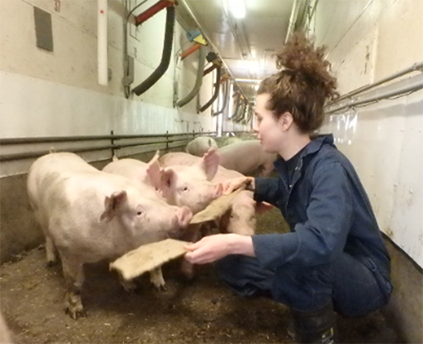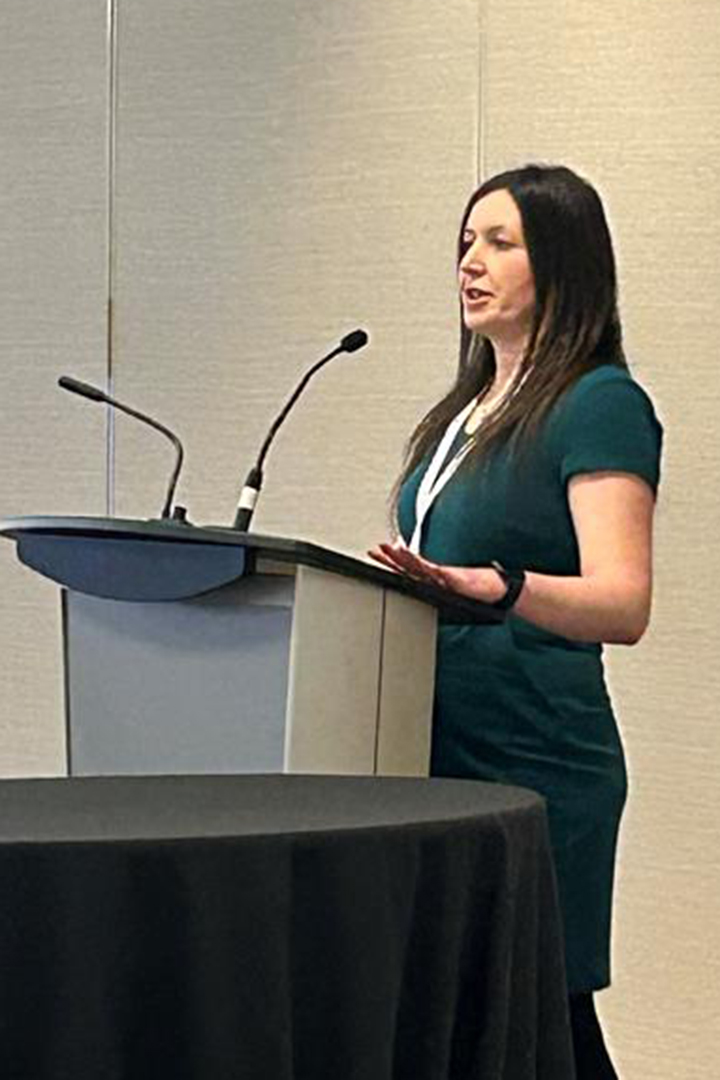
Canada’s pork industry renews financial investment in USask swine welfare chair
A group of Canadian pork industry partners have committed more than $1 million over five years to extend the critical role of a research chair in swine welfare at the University of Saskatchewan (USask).
By Tyler SchroederDr. Yolande Seddon (PhD), an associate professor in swine behaviour and welfare at the Western College of Veterinary Medicine (WCVM), was named the renewed USask Chair in Swine Welfare on Jan. 8 during the annual Banff Pork Seminar in Banff, Alta.
“This is a very special commitment that speaks to the unified engagement of the industry in supporting swine welfare,” says Seddon, whose research focuses on the behaviour and welfare of farmed pigs.
“A sustainable future for production efficiency and national food security is strengthened by addressing swine welfare challenges and advancing research in this area. This chair position is a major resource for supporting a strategic research focus, providing the Canadian swine industry with options for implementing our findings into industry practice.”
Seddon served as the Natural Sciences and Engineering Research Council of Canada (NSERC) Industrial Research Chair in Swine Welfare at USask from 2018 to 2024. The $2-million research program was supported by NSERC and 14 industry partners — one of the largest partnerships of its kind in Canada.
Fourteen industry partners — including 13 of the original 14 industry partners — have extended their financial commitment to swine behaviour and welfare research, renewing a second chair term from 2024 to 2030. Representing Canadian pig producers and processors, the original partners include Olymel S.E.C./L.P., Maple Leaf Foods, HyLife Ltd., Conestoga Meat Packers, Sunterra Farms, BC Pork Producers Association (BC Pork), Alberta Pork, Saskatchewan Pork Development Board (Sask Pork), Manitoba Pork Council, Ontario Pork Producers Marketing Board, Porcima Inc. (a company of Les Éleveurs de Porcs du Québec), PEI Hog Commodity Marketing Board and New Brunswick Pork.
The latest addition is Swine Veterinary Partners, which includes four swine-focused veterinary clinics in Alberta, Manitoba, Ontario and Quebec.
Swine Innovation Porc (SIP), a national research and development organization for Canada’s swine sector, also provided $50,000 in support of the USask swine welfare group during the chair’s transition period.

“This is a significant investment within our industry,” says René Roy, chair of the Canadian Pork Council (CPC). “By supporting this critical research, we are not only improving animal welfare but also ensuring that the Canadian pork sector remains a leader in responsible, science-based practices. This investment represents a forward-thinking approach to improving the well-being of pigs and advancing the sustainability of our industry.”
More than 7,000 pig farms across Canada produce over 25 million pigs each year for commercial pork production. As the third-largest pork exporter in the world, Canada’s swine industry annually generates nearly $5 billion in exports and is a vital contributor to the nation’s economic sustainability and growth.
Studies conducted by Seddon and her research team address important welfare challenges, the knowledge of which can be used to help advance sustainable swine farming practices. In her renewed role, Seddon will continue providing strong leadership in swine welfare research and industry expertise.
“Dr. Seddon set out to conduct foundational research that would help Canada’s swine industry meet changes addressing animal welfare in all aspects of pork production, and the breadth of work that she and her team have accomplished in the past five years is phenomenal,” says Dr. Gillian Muir (DVM, PhD), WCVM dean.
“What’s exciting to see is the industry’s commitment to this research program and to animal welfare. Renewed industry support means Dr. Seddon and her team have the resources they need for continued research momentum to scientifically assess key questions about swine behaviour and welfare, to help the industry develop practical solutions, and to play a vital role in shaping the future of swine production.”
During the chair’s first term, Seddon and her research team worked to enhance knowledge in four key areas critical to advancing swine welfare.

The first goal focused on studying how the early-life management of pigs contributes to their social development and stress responsiveness to subsequent events. They studied the development of the pigs reared with management strategies designed to support healthy behaviour development (social behaviours and foraging) and reduce stress reactivity, and then investigated the effects for short and long-term welfare outcomes.
“We found that applying these specific early-life strategies in both the farrowing and nursery [barns] had a positive effect on pig development: better social behaviours leading to reduced skin lesions, reduced tail biting, reduced fear of humans and better growth rates in the nursery, and improved growth rate extending lifelong,” says Seddon.
The second goal involved building an understanding of the role of play in enhancing positive pig welfare. Seddon and her colleagues showed that if pigs are provided with a simple intermittent enrichment routine involving novelty, it can create a positive event that encourages pigs to play. Behavioural and physiological measures collected — such as heart rate variability — indicate the expression of play is a rewarding activity for pigs and produces a calming effect through their parasympathetic nervous system.
“This suggests the expression of play leads to a positive emotional state,” says Seddon.
The third goal focused on identifying biological markers to support the evaluation of pig welfare, with a focus on tools that could support the evaluation of longer-term welfare states in swine.

“This industry is being tasked with proving that animal care is strong, robust and reliable, so we wanted to find markers for levels of welfare — providing tools for guiding decisions around animal care. We chose to study the measurement of hormone profiles in pig hair to evaluate if they provide information on whether a pig is chronically stressed or not stressed and coping well,” says Seddon.
She and her research team were able to identify ratios of certain hormones were elevated when pigs are injured or are sick. In the process, the researchers also provided additional support to other industry initiatives. They teamed up with a collaboration of swine genetic companies and Iowa State University to help them validate the use of these hormones as a measure to identify pigs that may show greater resilience to disease.
The fourth research goal looked at determining the value of collecting data on welfare indicators, observed on carcasses at the abattoir to provide information on the welfare that pigs experience on farms and in pre-slaughter handling.
“We can see from lesions on the skin aspects of what has happened in their life and the implications for welfare,” explains Seddon. “We’ve developed a fully automated swine welfare assessment system for scoring carcasses that uses a camera in the abattoir. It identifies, tracks and scans every pig that enters the slaughter line and reads the lesions across different parts of the body.”
This system is one of the first in the world that is capable of gathering data on a broader range of welfare lesions in this way.
“The value of such a tool is the ability to provide a continuous oversight of objective, accurate data on swine welfare that can be used as a feedback tool on animal welfare for the pork value chain,” says Seddon. “It supports continual improvement, whilst also collecting data for benchmarking and communication on animal care.”
Seddon and her team will continue to build their research program, exploring methods of implementing their findings into industry practices and investigating new areas of priority.
“When the industry initially came together in 2016 [for the application process], they put a lot of trust into my proposed concepts for addressing swine welfare challenges,” says Seddon. “After those five years, they’ve found the value in the work we’ve been exploring and there’s been an increase in their engagement in developing a new plan for the next term, which is quite significant.”
Seddon is grateful for the support of industry leaders who have provided sustainability and optimism for the program’s research.
“Agriculture sustainability is a major component of research at USask, and because our partners share in our vision, we’re able to build a valuable resource that will continue to advance swine welfare into the future.”
Together, we will undertake the research the world needs. We invite you to join by supporting critical research at USask.
